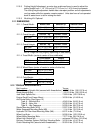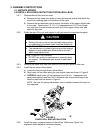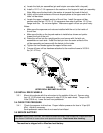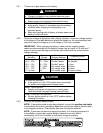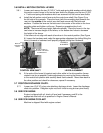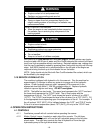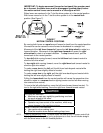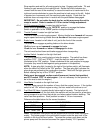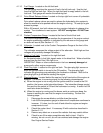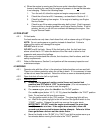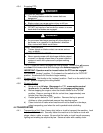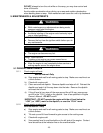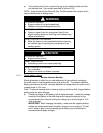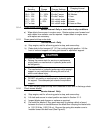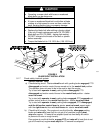
- 21 -
4.1.10 Fuel Gauge: Located on the left fuel tank.
The fuel gauge monitors the amount of fuel in the left tank only. Use the fuel
from the right fuel tank first. When the right fuel tank is empty switch to the left
fuel tank. Fuel gauge will monitor the remaining fuel.
4.1.11 Drive Wheel Release Valves
: Located on the top right front corner of hydrostatic
pumps.
Drive wheel release valves are used to release the hydrostatic drive system to
allow the machine to be pushed without the engine running. Tilt seat up to gain
access to pumps.
With a 5/8 wrench, turn both valves one turn counter-clockwise to release drive
system. Turn clockwise to reset system. DO NOT overtighten. DO NOT tow
machine.
4.1.12 Coolant Temperature Gauge:
Located at the front of the left fuel tank.
The coolant temperature gauge monitors the temperature of the engine coolant.
An engine overheating condition is indicated by the red area on the gauge and
an alarm will sound (See Section 4.1.17).
4.1.13 Voltmeter:
Located next to the Coolant Temperature Gauge at the front of the
left fuel tank.
The voltmeter measures the voltage output of the alternator. Both high and low
voltages will potentially damage the battery.
4.1.15 Water in Fuel Light:
Located on the right fuel tank.
An illuminated water in fuel light signals water in the diesel fuel. Water should be
drained from the fuel filter if the light is on.
IMPORTANT: Water or other contaminants in fuel can severely damage fuel
pump and/or other engine components.
4.1.16 Glow Plug Light:
Located on the right fuel tank. The glow plug light comes on
when the ignition switch is turned to the ON position. The glow plug light
indicates the glow plugs are preheating the combustion chamber. Wait for the
glow plug light to go out before starting the engine.
4.1.17 Warning Buzzer:
Located behind the seat on the left hand side of the engine air
deflector. The buzzer is a warning signal for the following circumstances:
a) When the engine is not running and the ignition switch is turned to the ON
position, the buzzer emits intermittent beeps. The intermittent beeps remind
the user that the switch is ON and the hourmeter is running. A switch left ON
could also drain the battery.
b) When the engine is running and the buzzer emits a continuous beep, the
buzzer is warning the user that the engine is overheating. Perform the
following steps.
1. Disengage the mower blades, and idle down the engine.
2. Look at the temperature gauge to determine if temperature continues to
increase. If it does, turn the unit off and allow the engine and engine
components to cool.
3. Check the coolant level. If necessary fill with coolant as described in
Section 5.1.2.
4. Remove any debris on or around the radiator that may restrict airflow.
5. Check to see if the water pump/alternator belt is intact. If belt is
missing, do not run unit, as unit can overheat and damage the engine.
See Engine Service Dealer.



